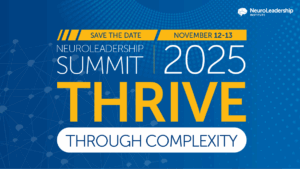Jay Van Bavel is a social neuroscientist who studies unconscious bias, group identity, and cooperation, specializing in understanding the neural mechanisms by which a sense of belonging to a group influence our thoughts and behavior.
His most recent study found that increasing a group’s sense of common identity leads to greater cooperation, coordination, and collective intelligence — all topics he will be discussing at the upcoming NeuroLeadership Summit. We reached him at his lab at New York University, where he is Associate Professor of Psychology and Neural Science and an affiliate at the Stern School of Business. He is also editor-in-chief of the NeuroLeadership Journal and serves as one of our senior scientists.
 NLI: What are you working on that’s most exciting to you right now?
NLI: What are you working on that’s most exciting to you right now?
Jay Van Bavel: I’m working on how to understand group coordination and cooperation. We’ve found that when you build a sense of common identity in a group, that leads to greater cooperation, and people are willing to sacrifice more to make the group succeed. They’re also more collectively intelligent.
NLI: Can you define collective intelligence?
JVB: Groups that perform better than the sum of their parts are considered collectively intelligent. Great groups outperform groups that might have a smarter person or a higher average intelligence. They’re really good at problem-solving tasks and creativity tasks.
What’s going is that they’re communicating very well, making sure everybody’s insights are considered. This allows them to brainstorm and come up with different ways to solve the problem.
NLI: Can you tell me how group identity fits into your recent study?
JVB: We measured group identity and found that groups with the most pride and common connection to their team perform best at cooperation games.
In one condition, we tell people they’re all competing against each other and the best individual is going to win. When we do that, they don’t work well together. Their performance isn’t very good.
But when we tell people they’re working as a team to compete with other teams, it’s in that condition that they work best with the group they’re with and cooperate the most. Those teams end up having the best problem-solving.
NLI: You’ve designed these tasks where cooperating increases the team’s performance as a whole. Is that the kind of task that best reflects what people typically have to do in organizations in the real world? Are business tasks generally tasks where a group cooperating is does better than individuals working independently and solo?
JVB: Yes. In science, the best papers are driven by teams of great people working together. Even though we have this notion of Einstein, that’s not how science works. The most impactful science is done by teams, not by a single genius.
In Hollywood, Pixar is famous for having these incredible creative teams that go off and do their bits and then come back and share knowledge and give each other critical feedback.
Some tasks, like sales, are individualistic — you have people out in the field knocking on doors or making calls one-on-one.
NLI: Yes! And salespeople need support, too.
JVB: Most work nowadays — especially really complex high-impact work or creative work — is done in groups or teams.
NLI: What can organizations do to increase cooperation in their teams?
JVB: There’s a couple of things. One, they need to build a common sense of identity on teams that are working together. What we’ve found is that (A) you can measure it, so you can see which teams already have that kind of identity. And (B), you can manipulate it — managers and leaders can be empowered to create that sense of identity.
Research has found that diverse teams benefit the most from having a group identity, because it helps them get on the same page and put aside their differences. Then they can use their different insights to solve a problem together, without the conflict that normally would come from that — and without breaking into a bunch of individuals.
NLI: How can organizations create a culture of cooperation?
JVB: Cooperation is hard. It takes a lot of prefrontal cortex activity to overcome your impulse to be selfish and instead engage in cooperation. We found that people who have damaged their prefrontal cortex can’t do it. That same logic probably also applies if you’re distracted — it might make cooperation hard.
But if you’re working with a group of cooperative people — if you’re in a cooperative team or an organization with a cooperative culture — all of a sudden cooperation becomes easy. It no longer requires your lateral prefrontal cortex, your working memory, or executive function — and it seems to feel good.
Once you turn the corner and create a culture of cooperation, people get a reward signal when they make decisions to cooperate, so it becomes easier. It doesn’t require as much self-control and regulation, and they can do it without thinking.
We’ve looked at data from around the world from thousands of people, and we’ve found that in places where cooperation is common, people do it automatically. Whereas if they’re coming from places where cooperation is not common, like Manhattan, then it’s hard for them, and it takes them longer to come to the decision to cooperate.
NLI: What are people responding to exactly? Is it the norms of the group they’re in?
JVB: Yup, exactly. Norms. Of course, some people pick up on norms and other people don’t. This really only applies to people who are paying attention to the norms around them. When the norms are good, they cooperate.
NLI: So how can an organization create a norm of cooperation?
JVB: Several things. First, they can hire cooperators. Hire people who are cooperative and don’t hire people with sharp elbows.
Second, promote and reward people — especially in public ways — who show that they value cooperation and collaboration.
Third, leadership can send signals by being role models. If you put people in a group with somebody who’s a “supercooperator,” who’s super helpful, then for people who are on the fence about what to do, it triggers their cooperative instinct and they jump in and get cooperative.
The other thing we found — and this is remarkable — is then if you take that person who was on the fence and put them in a new group, now they become the supercooperator in the new group! And it then triggers other people to jump in and be cooperative, so you have this ripple effect — a cascade of cooperation and collaboration.
NLI: You mentioned an individual difference where some people pick up on group norms and some don’t. How do you reach people who don’t pick up on the norms?
JVB: Those people are harder to reach. Most people pick up on the norms of the group. But for some people, you have to make it explicit. That’s going to come out the language you use, the reward structure you create, and the signals leaders give.
NLI: You mentioned the idea of an individual who’s a “supercooperator.” Can you tell me about those kinds of people and what their traits are?
JVB: About 5 to 10% of people are what we can call here “supercooperators.” If they’re playing a cooperation game with other people, they will give every time, even if they’re being taken for a sucker and other people are exploiting them.
Economists predicted that these people would not exist. But here’s why they exist. It’s because other people — people who might be on the fence — they see that and it triggers them to cooperate. Then they start working with that person, and other people see that person and start to value them more, and they get invited to other events where they get the chance to cooperate. That’s the strategy of supercooperators.
Rational economists think these people shouldn’t exist because they’re just going to get exploited. Well, they actually get all kinds of rewards in the long run. They get invited to more opportunities to collaborate, they trigger other people around them to collaborate and cooperate, and it ripples out — and that’s where you can have cooperation that goes viral.
ut you need somebody to trigger that. It turns out 1 in 10 or 1 in 20 people are that person.
NLI: But ordinary people can also be turned into supercooperators?
JVB: Yes. Most people are what’s called “conditional cooperators.” They’ll cooperate when it’s rewarded, but they’re selfish if they see everybody else be selfish and selfishness is rewarded.
But you can nudge people to be supercooperators if they’re around other supercooperators. That’s when you get these cultures like Pixar that thrive because they create a culture where everybody’s helping everybody. Everybody’s sharing information and giving creative insights and everybody wants everybody else to succeed.
Once you create that culture, 60% of people who are on the fence start to get nudged every day in little ways into that supercooperator mode they have within them.
NLI: Would you call cooperation and collaboration a “mindset”? Is it analogous to Growth Mindset — like Cooperative Mindset?
JVB: I would call it “cooperative cultures,” but you could call it Cooperative Mindset. You can put people into a Cooperative Mindset or a Selfish Mindset.
NLI: Are there cues that trigger Selfish Mindset? And should organizations be trying to eliminate those cues?
JVB: Totally! My dad used to be in used car sales. In the manager’s office, they posted charts that showed all the car salesmen and their sales for the week. You could see who was selling the most cars, and at the end of the month, the person who sold the most got a bonus.
And what would happen is no one helped each other close a sale! Say you were about to close a sale with one customer, then a customer you’d been working the previous week walked in ready to buy a car. What you should do is say to your colleague, “Hey, you close this deal and I’ll split the commission with you.”
But no one ever did that! They’d just send the person home and say, “Come see me another time.” And if the person didn’t come back, the dealership lost a sale.
It creates a sharp elbows and very selfish mindset that’s not in the dealership’s best interest. Their goal should be to sell as many cars as possible — not to have the best salesmen possible.
NLI: The sales bonus system incentivized competitive behavior and performance, but it’s incompatible with Cooperative Mindset.
JVB: Yeah! That incentive system — that’s the old way of thinking about this. What we should be doing instead is look at an organization’s higher goals and ask: Are they nudging people and rewarding people and sending the right signals to get people to do the things we actually care about?
NLI: Any other advice for organizations about creating super successful teams?
JVB: I would just say the big thing is: Think about identity — how to create a powerful, compelling group identity. That’s the key to unlocking our potential.
[action hash=”6cd538cd-54dd-4b69-a152-d85ebcd24518″]





